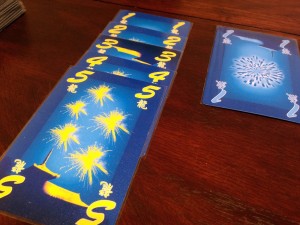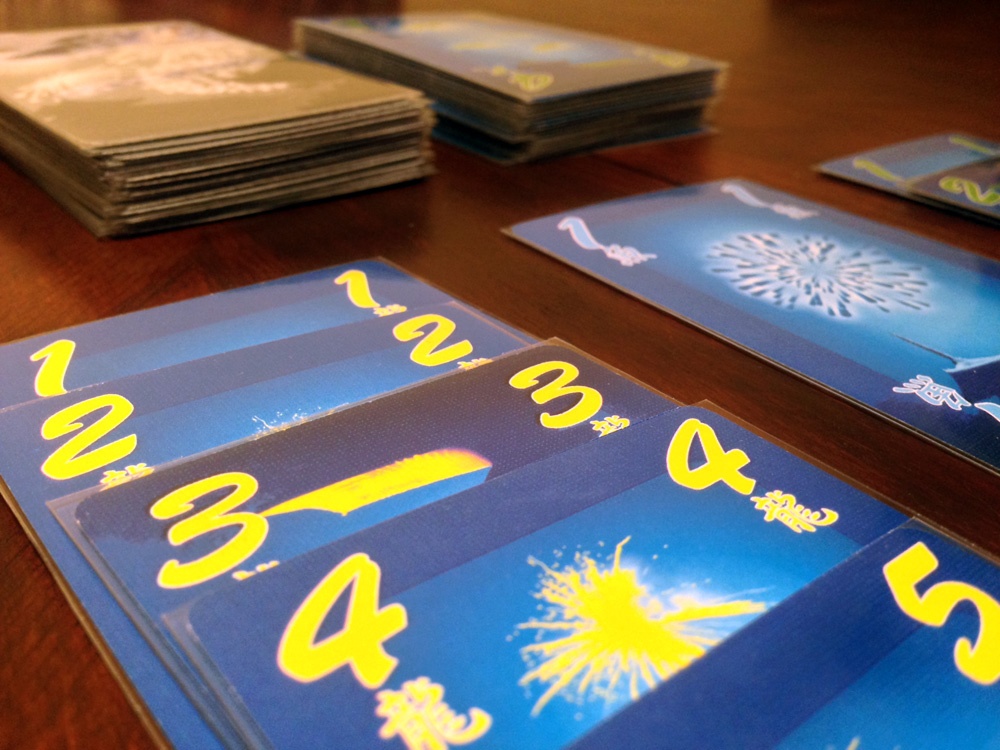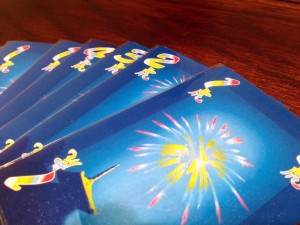 It’s hard not to love fireworks. Watching streaking bits of fire shoot into the sky and explode into a multicolor burst can entertain you on a primal level. As our caveman ancestors marveled at the fire they created, so do also we love watching explosion in the sky. For my money, you’d be hard pressed to find a better way to mark an occasion than with some good pyrotechnics. This brings us to the theme of the award winning card game Hanabi. This unassuming card game won the 2013 Spiel des Jahres (German Game of the Year) award, which is given out to high quality and very accessible, tabletop games. Is Hanabi a worthy winner of this award or should it be blasted away? Read on!
It’s hard not to love fireworks. Watching streaking bits of fire shoot into the sky and explode into a multicolor burst can entertain you on a primal level. As our caveman ancestors marveled at the fire they created, so do also we love watching explosion in the sky. For my money, you’d be hard pressed to find a better way to mark an occasion than with some good pyrotechnics. This brings us to the theme of the award winning card game Hanabi. This unassuming card game won the 2013 Spiel des Jahres (German Game of the Year) award, which is given out to high quality and very accessible, tabletop games. Is Hanabi a worthy winner of this award or should it be blasted away? Read on!
Hanabi is a cooperative memory and deduction card game for 2-5 players that plays in about 20 minutes. Hanabi plays best with 4 players.
Game Overview:
Hanabi, the Japanese word for fireworks, is about putting on the best possible firework show for your audience. The game is played with a deck of cards consisting of numbers 1-5, each of which in 5 different colors. Each player is dealt a hand of 5 cards, but the catch is they may not look at them. Instead, the players hold the cards facing their fellow players. Players must give each other clues and use some good old fashioned deduction to play their cards correctly. Players will need to collectively play their cards in increasing order, and by color. The game ends when either the players have completed all 5 sets, run out of cards in the draw deck, or made three errors during the game. They then total their score and see how close they are to a perfect 25.
Components:

There is not really much to say about the components in Hanabi. The game comes with 60 cards that depict a fireworks explosion on the front and have a greyscale back. Each card has a number in one of 6 different colors. Overall, the cards are functional and aesthetically pleasing, but nothing groundbreaking.
The game also includes 12 cardboard tokens to both track clues in the game and also track how many mistakes the players have made.
How to Play:
As with any Spiel des Jahres winner, the game play in Hanabi is delightfully simple. The 50 cards are shuffled together and each player is dealt a hand of 5 cards that they may not look at. Players must hold their cards facing outward towards their fellow players. The goal will be for the players to correctly play their cards in an ascending, numerical sequence. Cards must also be played according to color.
One player is chosen to be the start player and each player takes a turn in a clockwise manner. On a player’s turn they may:
Give a clue: Players start with 8 clock tokens. By spending one of these, they may give a clue to one of their fellow players about the cards they hold. All clues must be something that you can point to (i.e. you have 1 yellow card here or these specific three cards are 4s). You cannot say “you don’t have any red cards.” The other caveat is that you must tell the player all of something. So if you tell them they have a red card, you must tell them each red card they hold.
Discard a Card: Once the players have used up all 8 of their clue tokens, they only way to get one back is by discarding a card. A player then draws a replacement card.
Play a Card: A player chooses a card from their hand and plays it to the table. If the card is a legal play, it goes into the corresponding pile. If there is nowhere to play the card, then it is discarded and the players lose a fuse token. If they make three such mistakes, the game ends and the players have lost.
The game continues in this manner until either the players have successfully played all 5 colors of cards up to the number 5 value. Or, more likely, the players run out of cards in the draw pile. At that point the players each get one more turn and the game is over. They total up the highest played card in each pile and this gives them their total score. There is a little chart included in the game to rate how they did up to a perfect 25 points.

Game Experience:
Hanabi is a really unique game. Designer Antoine Bauza (7 Wonders, Tokaido) got really creative when he designed this game. The first thing Hanabi does is punch centuries of conditioning square in the face. We are all taught that when you draw cards, you draw them so the other plays can’t see them and to quickly look at them. In Hanabi you do the exact opposite. Right off the bat I knew I was dealing with something new and fresh. That aside, as easy as the rules are to learn, Hanabi is not an easy game. To win that is.
It’s no surprise that Hanabi won the Spiel des Jahres award. That award is made for games that are easy to learn and very accessible. And Hanabi has that in spades. Creating runs of cards of the same color is a game we’ve all played before. But the monkey wrench that Hanabi throws at you is what makes the game so unique. I’ve played games with hidden information before. Usually it’s one card. Not all of your cards! But the deduction element of the game is what I love about Hanabi.

Sure there will be clues given out but player collectively only get 8 of them. Once players have spent most of their clue tokens, they may have to start blindly discarding cards and woe to the player that discards a 5. The cards are unevenly split (1,1,1,2,2,3,3,4,4,5), so if you drop a 5, you now have no chance at a perfect score. So to try and minimize these costly mistakes, eventually players will have to start using some deduction.
I think this is a game where the more you play with someone, the better you will become at it. Much like in Dixit, where when you know someone really well, you can give clues only they understand. In Hanabi, it helps to be able to read your partner(s). This game isn’t only about the clues you give, it’s also about the clues you don’t give. It’s also about when you give the clues as well. This is especially true when you get deep into the game and the clue tokens become very scarce. Sometimes you just don’t have enough tokens to tell a player everything they need to know. You want to scream PLAY THIS CARD DUMMY, but you can’t. So instead, you say “You have one green card”, but you say it in that deep, off-pitch kind of voice so they not-so-subtly get the hint to play that card. Eventually, your fellow players will understand your logic and reasoning, your subtle clues and how you think, and you will get better at the game. But it will take some time, and a lot of attention to detail.
And Hanabi is a game that demands your attention. This is not a game that you can casually play while holding a conversation or watching a football game. If you don’t fully commit yourself to your cards and the game, you will lose…painfully. I have a hard enough time keeping track of what my cards are when we are completely focused on the game, that I couldn’t imagine playing this one with distractions.
Hanabi also does a great job of solving the “quarterbacking” problem found in many cooperative games. It’s really hard for one player to take over the game when they don’t even know the cards in their hand. This game truly demands teamwork to succeed.
One thing I’ve noticed playing this game is that the perceptive players will have an easier time with more people. In a 4 player game, players are not only cycling through the deck faster (thus, stopping a bad shuffle from screwing up their plans), but they also have access to more information. In a two player game, you only see your partner’s cards. But in a 4 player game, you see 3 other sets of cards. That, combined with what has already been played/discarded, can allow a player to have an easier time deducing what cards they have in their hand. You can start playing the odds. If someone tells you that you have a yellow card and all but 2 of them are either in play or other player’s hands, you can take a good guess at what you have. Even still, I have no issues playing Hanabi at any player count. It’s highly enjoyable from 2-5.
Final Thoughts:

Overall, Hanabi makes for a unique, cooperative game that is incredibly accessible. Just about anyone, from young kids at home to relatives who are still playing rummy, can jump right in and play Hanabi. The easy to learn rules will get it to the table often and the challenge will even keep the dedicated gamers entertained. There is a lot to love in this little box.
After spending some time with Hanabi, it’s clear as to why this game won the Spiel des Jahres. Being incredible accessible is a requirement for that award and Hanabi has that in spades. This unique game is both fun to play and a challenge that will drive you to do better and better.
I don’t have a lot of complaints with the game. Hanabi is fun, the cost is very affordable and it has made its way to the table many times already. The game also includes a 6th set of rainbow colored cards that you can use to make the game harder or easier. Considering all that is offered in this little box, I can’t think of very many reasons not to own a copy of Hanabi. Pick up this award winner today.
If you are interested in getting a copy for yourself, it’s about $10
Final Score: 4.5 Stars – A cooperative game that’s very easy to learn, will appeal to just about everyone and is a whole lot of fun.
 Hits:
Hits:
• Very Accessible
• Easy to Learn
• Cooperative game without “quarterbacking”
• Quick playing
Misses:
• Players with bad memories or prone to distractions will have a hard time.





















Ok, got it…NOT! Matt is this like me with Pai Gown where it’s easier when you play it?
The german printed version of the rules states clearly that you can inform “You have no red cards” or “You have no Nº 2 cards”, contrary to what is stated here,
The English rules (by RandR Games) clearly state that saying that is NOT allowed. You MUST be able to point to the cards your hint is about. So you cannot say “You have no red cards”.
How about if I point to your hand and say “none of these cards are red”? 😛